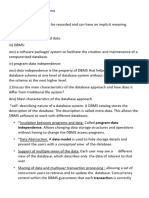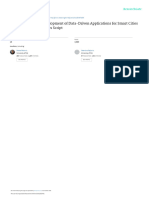0 ratings0% found this document useful (0 votes)
9 viewsMIS Final Exam NOTES
MIS Final Exam NOTES
Uploaded by
samlovesham59final exam study guide (management information systems)
Copyright:
© All Rights Reserved
Available Formats
Download as DOCX, PDF, TXT or read online from Scribd
MIS Final Exam NOTES
MIS Final Exam NOTES
Uploaded by
samlovesham590 ratings0% found this document useful (0 votes)
9 views4 pagesfinal exam study guide (management information systems)
Copyright
© © All Rights Reserved
Available Formats
DOCX, PDF, TXT or read online from Scribd
Share this document
Did you find this document useful?
Is this content inappropriate?
final exam study guide (management information systems)
Copyright:
© All Rights Reserved
Available Formats
Download as DOCX, PDF, TXT or read online from Scribd
Download as docx, pdf, or txt
0 ratings0% found this document useful (0 votes)
9 views4 pagesMIS Final Exam NOTES
MIS Final Exam NOTES
Uploaded by
samlovesham59final exam study guide (management information systems)
Copyright:
© All Rights Reserved
Available Formats
Download as DOCX, PDF, TXT or read online from Scribd
Download as docx, pdf, or txt
You are on page 1of 4
Study Guide for Principles of Information Systems
Chapter 1: An Introduction to Information Systems
Definition: IS integrates technology, people, and processes.
Key Concepts:
Components of IS: Hardware, software, data, people, and
processes.
Types of IS: TPS, MIS, DSS, and ESS.
Role of IS in organizations: Strategic advantage, decision-making,
and efficiency.
Chapter 2: Information Systems in Organizations
The Role of IS:
Supporting operations, management, and decision-making.
Competitive strategies: Cost leadership, differentiation, and
niche focus.
Organizational Structure:
How IS aligns with functional units (HR, Marketing, Finance).
Change Management:
Implementing IS and overcoming resistance.
Chapter 3: Hardware: Input, Processing, and Output Devices
Hardware Components:
Input devices: Keyboards, scanners.
Processing: CPU, memory (RAM, ROM).
Output devices: Monitors, printers.
Trends: Cloud computing and edge computing.
Chapter 4: Software: Systems and Application Software
Types of Software:
System software: Operating systems (Windows, macOS).
Application software: Productivity tools, custom applications.
Trends in Software:
Open source, SaaS, and virtualization.
Chapter 5: Database Systems and Big Data
Data Management:
Databases: Relational, NoSQL.
Database Management Systems (DBMS): Functions and benefits.
Big Data:
Characteristics (3 Vs: Volume, Velocity, Variety).
Tools: Hadoop, Spark.
Chapter 6: Telecommunications and Networks
Networking Basics:
LAN, WAN, Internet.
Protocols: TCP/IP, HTTP.
Emerging Technologies:
5G, IoT.
Security Concerns: Encryption, firewalls.
Chapter 7: The Internet, Intranets, and Extranets
Internet Basics:
Key services: Email, WWW.
Search engines and SEO.
Intranets/Extranets:
Internal collaboration tools.
B2B communication.
Chapter 8: Electronic and Mobile Commerce
E-Commerce Types:
B2C, B2B, C2C.
Mobile Commerce (M-Commerce):
Apps and mobile payment systems.
Legal/Ethical Issues: Privacy, data protection.
Chapter 9: Enterprise Systems
Enterprise Resource Planning (ERP):
Integrates all functional areas.
Customer Relationship Management (CRM):
Tools to manage customer interactions.
Supply Chain Management (SCM):
Managing logistics, inventory.
Chapter 10: Information and Decision Support Systems
Decision Support Systems (DSS):
Tools to analyze data and make decisions.
Business Intelligence (BI):
Dashboards, predictive analytics.
AI in DSS: Chatbots, machine learning.
Chapter 11: Knowledge Management and Specialized Information
Systems
Knowledge Management (KM):
Capturing and sharing organizational knowledge.
Specialized IS:
GIS, Expert Systems.
Trends: AI, machine learning applications.
Chapter 12: Systems Development: Investigation and Analysis
Systems Development Life Cycle (SDLC):
Phases: Planning, Analysis, Design, Implementation,
Maintenance.
Agile vs. Waterfall Methodologies:
Comparison of iterative and structured approaches.
Chapter 13: Security, Privacy, and Ethical Issues in Information
Systems
Security Risks:
Malware, phishing, ransomware.
Preventative Measures:
Anti-virus software, employee training.
Ethical Issues:
Surveillance, intellectual property, digital rights.
You might also like
- Iso 14641-2018Document50 pagesIso 14641-2018Pacific CertificationsNo ratings yet
- Information Systems Course OutlineDocument3 pagesInformation Systems Course Outlineapi-3737023100% (3)
- Information Technology (IT) OverviewDocument5 pagesInformation Technology (IT) Overviewdushyant.novelNo ratings yet
- EIT-505 Information Security and Cyber Laws: Unit-IDocument7 pagesEIT-505 Information Security and Cyber Laws: Unit-IVikrant VermaNo ratings yet
- Components of Information SystemsDocument57 pagesComponents of Information SystemsG JeevaNo ratings yet
- Information and Knowledge SystemsDocument5 pagesInformation and Knowledge SystemsKeerthana RameshNo ratings yet
- Panjab University ChandigarhDocument7 pagesPanjab University ChandigarhPushpendra Singh RanaNo ratings yet
- Basics of Information Technology, Windows OS and MS OfficeDocument78 pagesBasics of Information Technology, Windows OS and MS Officevaibhavbiradar331No ratings yet
- Chaudhary Charan Singh University, MeerutDocument4 pagesChaudhary Charan Singh University, MeerutSatyarth PundirNo ratings yet
- SVKM's NMIMS University Mukesh Patel School of Technology Management & EngineeringDocument3 pagesSVKM's NMIMS University Mukesh Patel School of Technology Management & EngineeringmgordhandasNo ratings yet
- Course OutlineDocument5 pagesCourse OutlinensanjashaficNo ratings yet
- Lecture #4Document23 pagesLecture #4Attaya HassanNo ratings yet
- ICT-2Document41 pagesICT-2chatgtdhruvrathee11No ratings yet
- Unit5 - EmergTrendsIn ITDocument47 pagesUnit5 - EmergTrendsIn ITKunal SinghNo ratings yet
- BIDocument35 pagesBIKarishmaNo ratings yet
- Unit Five What Is KDD?Document3 pagesUnit Five What Is KDD?kamalshrishNo ratings yet
- Syllabus Bca - Ii Year (L.E.)Document12 pagesSyllabus Bca - Ii Year (L.E.)TheRHKapadiaCollegeNo ratings yet
- Introduction To Information SystemsDocument4 pagesIntroduction To Information SystemsA TrimboliNo ratings yet
- Chapter 1 - IntroductionDocument18 pagesChapter 1 - Introductionnurraihan fatihahNo ratings yet
- MMPC008Document5 pagesMMPC008210010502041.mgtNo ratings yet
- BA4106 Information Management Notes Unit 1Document46 pagesBA4106 Information Management Notes Unit 1Sathish kumar JayabalanNo ratings yet
- 1805136965-PG - ITSM 3 & 4 semDocument11 pages1805136965-PG - ITSM 3 & 4 semrohanNo ratings yet
- Mba4001 - MisDocument1 pageMba4001 - Missanjeev_singh_17No ratings yet
- SyllabusDocument2 pagesSyllabusporseenaNo ratings yet
- Phobia (Disease)Document5 pagesPhobia (Disease)Naim MirzaNo ratings yet
- Publication 11 15953 1575Document7 pagesPublication 11 15953 1575Muhammad SaleemNo ratings yet
- Computer Graphics and Animation: TMC 501Document4 pagesComputer Graphics and Animation: TMC 501Vibhor MittalNo ratings yet
- Information SystemDocument15 pagesInformation SystemMuhammad TahaNo ratings yet
- MBA Synopsis Ronik OberoiDocument30 pagesMBA Synopsis Ronik Oberoikomal Koundal 20No ratings yet
- Information SystemDocument25 pagesInformation Systemsamuelgyau110No ratings yet
- Digital Awareness Cyber SecurityDocument110 pagesDigital Awareness Cyber SecurityAjay PatelNo ratings yet
- CDI 9 Module 2Document15 pagesCDI 9 Module 2Patrick CruzNo ratings yet
- Mis SyllabusDocument3 pagesMis SyllabusMalini MaluNo ratings yet
- MANAGEMENT-INFORMATION-SYSTEMSDocument12 pagesMANAGEMENT-INFORMATION-SYSTEMSBea CataneoNo ratings yet
- Mis SyllabusDocument3 pagesMis SyllabusMalini MaluNo ratings yet
- BA4106 - Information Management - Notes - Unit-1Document46 pagesBA4106 - Information Management - Notes - Unit-1Shapnam Marziya M75% (4)
- Gemini MIS Assignment by Hamza MuazzamDocument13 pagesGemini MIS Assignment by Hamza Muazzambhalikhaliq558No ratings yet
- Introduction to IoTDocument40 pagesIntroduction to IoTsaigangadharavirothiNo ratings yet
- Introduction To Information Technology (Week 1)Document24 pagesIntroduction To Information Technology (Week 1)constantinolito77No ratings yet
- Chapter 1Document4 pagesChapter 1HayelomNo ratings yet
- MISC 116 Course OutlineDocument2 pagesMISC 116 Course OutlineFer LeroyNo ratings yet
- D F Unit-2-NotesDocument40 pagesD F Unit-2-Notesraghuramd400No ratings yet
- Course No 405 Decision Support Systems Management Information System Short NotesDocument12 pagesCourse No 405 Decision Support Systems Management Information System Short Notesanthony patoleNo ratings yet
- University of Nairobi: School of Business Department of Management Science MBA (SEP-DEC 2020) Dis511: Information SystemsDocument2 pagesUniversity of Nairobi: School of Business Department of Management Science MBA (SEP-DEC 2020) Dis511: Information SystemsBenardMbithiNo ratings yet
- Informatics Practices: Syllabus For Higher Secondary Stage (Class XI and XII)Document8 pagesInformatics Practices: Syllabus For Higher Secondary Stage (Class XI and XII)Aditya Gatadi KhandobaNo ratings yet
- Mis - Rim M1,2Document34 pagesMis - Rim M1,2Jaan MukherjeeNo ratings yet
- MISDocument4 pagesMISJayaJayashNo ratings yet
- Marketing Question VivaDocument4 pagesMarketing Question VivaMithun NairNo ratings yet
- ManagementDocument5 pagesManagementKunal ObhraiNo ratings yet
- Full Stack DevelopmentDocument6 pagesFull Stack Developmentoj227754No ratings yet
- Cyber Security Full 2024Document80 pagesCyber Security Full 2024majproj12No ratings yet
- Computer ScienceDocument27 pagesComputer Scienceanurag_garg_20No ratings yet
- 8 A 8 D 4Document2 pages8 A 8 D 4dhairyachaudhary24No ratings yet
- Chapter 1Document40 pagesChapter 1Abdurezak AhmedNo ratings yet
- Chapter - 1 IS To FBDocument17 pagesChapter - 1 IS To FBEndalkachew EmareNo ratings yet
- Time Paper Code: 2.32DEDocument2 pagesTime Paper Code: 2.32DEpclnmiitNo ratings yet
- Prepared By: MR Dawit .BDocument22 pagesPrepared By: MR Dawit .BDawit BirhanuNo ratings yet
- AI and ML NotesDocument8 pagesAI and ML Notesfatimahasnain410No ratings yet
- Information Technology (IT) ConceptsDocument2 pagesInformation Technology (IT) Conceptsaalexa1107No ratings yet
- UntitledDocument9 pagesUntitledShahzaibNo ratings yet
- Power AI: Revolutionizing the Future with Advanced Artificial Intelligence: 1, #1From EverandPower AI: Revolutionizing the Future with Advanced Artificial Intelligence: 1, #1No ratings yet
- Personal LettersDocument10 pagesPersonal LettersMariani KamilNo ratings yet
- Artificial Intelligence Based Person Identification Virtual AssistantDocument5 pagesArtificial Intelligence Based Person Identification Virtual Assistantrock starNo ratings yet
- ARTIFICIAL INTELLIGENCE - TERMINOLOGIESDocument20 pagesARTIFICIAL INTELLIGENCE - TERMINOLOGIESLavin BhawnaniNo ratings yet
- Assign 1 Data Struct PDFDocument3 pagesAssign 1 Data Struct PDFxariey30No ratings yet
- Kartik JavaDocument2 pagesKartik Javanaman3504No ratings yet
- Orange AI417 09 MSDocument7 pagesOrange AI417 09 MSsukumarsidNo ratings yet
- System Administration and Maintenance Midterm Exam Attempt Review PDFDocument2 pagesSystem Administration and Maintenance Midterm Exam Attempt Review PDFLollz AutidaNo ratings yet
- Object Oriented Programming Lab Manual (Lab 10) : Topic: File HandlingDocument6 pagesObject Oriented Programming Lab Manual (Lab 10) : Topic: File HandlingAli RazzaqNo ratings yet
- Dbms Module 1 Questions With AnswersDocument7 pagesDbms Module 1 Questions With AnswersRupith Kumar .NNo ratings yet
- LO2a) - Introduction To Data EngineeringDocument32 pagesLO2a) - Introduction To Data EngineeringAli Azgar KathaNo ratings yet
- House Price Prediction - Research Paper FINAL DRAFTDocument10 pagesHouse Price Prediction - Research Paper FINAL DRAFTSarthak Jain100% (1)
- Machine LearningDocument13 pagesMachine LearningPappu PNo ratings yet
- Elevator ControlerDocument2 pagesElevator ControlerStrahinja weNo ratings yet
- Top 42 Microstrategy Interview Questions and AnswersDocument14 pagesTop 42 Microstrategy Interview Questions and AnswersJacky GurnaniNo ratings yet
- Fake Media Detection Based On Natural Language Processing and Blockchain ApproachesDocument12 pagesFake Media Detection Based On Natural Language Processing and Blockchain ApproachesZeinab ShahbaziNo ratings yet
- CST466 DATA MINING, OCTOBER 2023.pdf - CrdownloadDocument3 pagesCST466 DATA MINING, OCTOBER 2023.pdf - Crdownload20b739No ratings yet
- MY RESUME 2025-CompressedDocument1 pageMY RESUME 2025-CompressedManikantaNo ratings yet
- Enhancing Drug Information Access: AI-Powered System With Large Language Models and Chatbot IntegrationDocument6 pagesEnhancing Drug Information Access: AI-Powered System With Large Language Models and Chatbot IntegrationInternational Journal of Innovative Science and Research TechnologyNo ratings yet
- Class 9th Neural Networks QAnsDocument2 pagesClass 9th Neural Networks QAnsFarhan Khan100% (1)
- Ubiquitios Information Technologies and Applications CUTE2012Document864 pagesUbiquitios Information Technologies and Applications CUTE2012trab nadraNo ratings yet
- CITS4243: Advanced Databases: Datta@csse - Uwa.edu - AuDocument51 pagesCITS4243: Advanced Databases: Datta@csse - Uwa.edu - Auravi198715No ratings yet
- Cybs2122 Introduction To Artificial Intelligence Week 10Document5 pagesCybs2122 Introduction To Artificial Intelligence Week 10prij469No ratings yet
- Interlinear gloss.Document6 pagesInterlinear gloss.abualdien441No ratings yet
- Semantic Web and OntologiesDocument61 pagesSemantic Web and OntologiesNaglaa FathyNo ratings yet
- 2544 P502a20 Iso Awa23004007 0001 - 1Document3 pages2544 P502a20 Iso Awa23004007 0001 - 1ahmed marieNo ratings yet
- Data WarehouseDocument3 pagesData WarehouseInformation technologyNo ratings yet
- Cs1 MWT IntroDocument28 pagesCs1 MWT IntrolikhitgatagatNo ratings yet
- CT075!3!2 DTM Topic 0 Introduction UpdatedDocument20 pagesCT075!3!2 DTM Topic 0 Introduction Updatedkishanselvarajah80No ratings yet
- ApproachtoRapidDevelopmentofData-DrivenApplicationsforSmartCitiesusingAppSheetandAppsScriptDocument6 pagesApproachtoRapidDevelopmentofData-DrivenApplicationsforSmartCitiesusingAppSheetandAppsScriptAishah AmanNo ratings yet

























































































